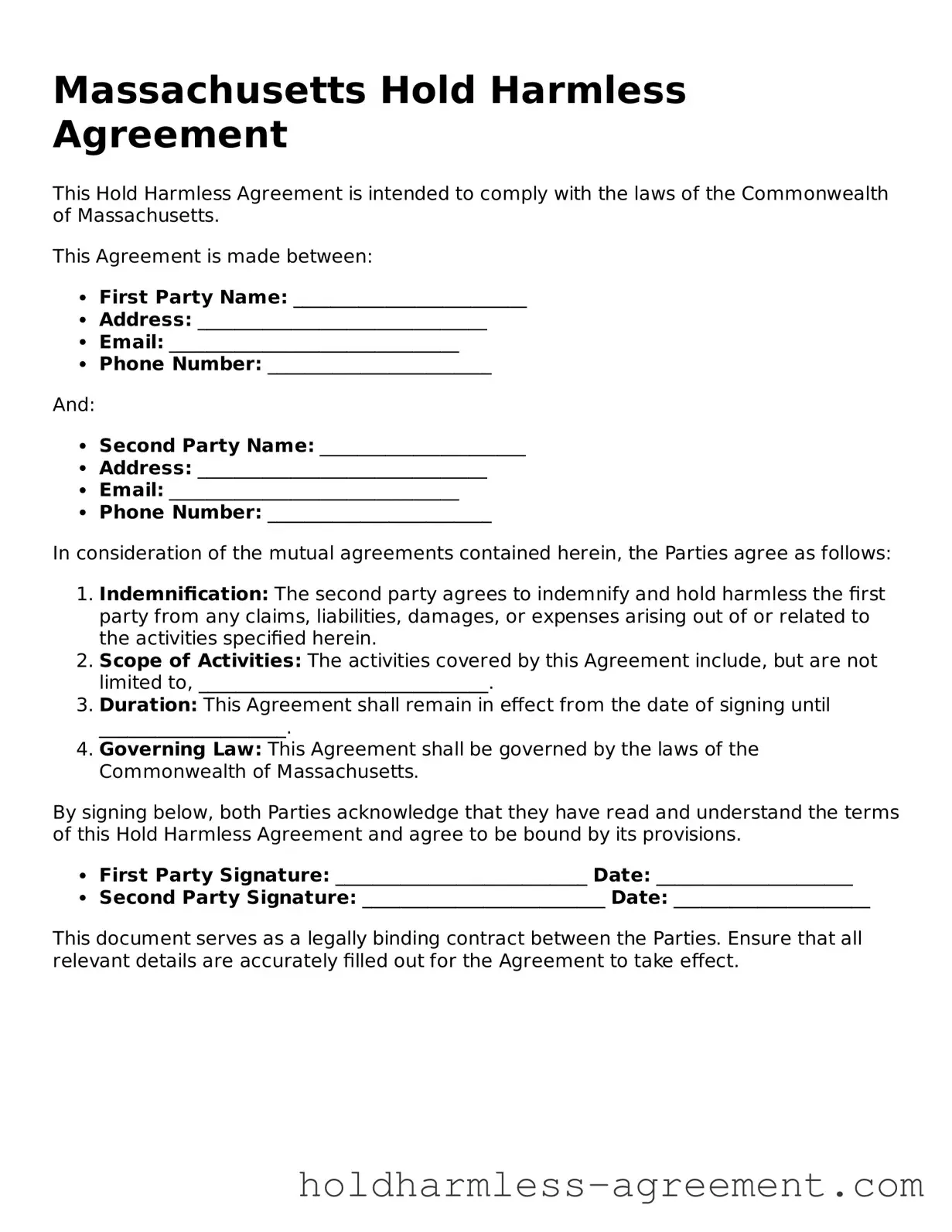What is a Hold Harmless Agreement in Massachusetts?
A Hold Harmless Agreement is a legal document that protects one party from liability for any injuries or damages that may occur during a specific activity or event. In Massachusetts, these agreements are often used in various contexts, such as rental agreements, event planning, and construction projects. By signing this agreement, one party agrees not to hold the other party responsible for certain risks associated with the activity.
Who typically uses a Hold Harmless Agreement?
Various individuals and organizations utilize Hold Harmless Agreements, including:
-
Property owners renting out their spaces
-
Event organizers hosting gatherings
-
Contractors and subcontractors in the construction industry
-
Nonprofit organizations holding events
These agreements help manage risk and clarify responsibilities among the parties involved.
What are the key components of a Hold Harmless Agreement?
A typical Hold Harmless Agreement includes several essential elements:
-
Identification of Parties:
Clearly identify the parties involved in the agreement.
-
Description of Activity:
Provide a detailed description of the activity or event covered by the agreement.
-
Liability Waiver:
Include a clause that specifies the extent of liability being waived.
-
Duration:
State the duration of the agreement, indicating whether it is for a specific event or an ongoing relationship.
-
Signatures:
Ensure that all parties sign the agreement to acknowledge their acceptance of its terms.
Is a Hold Harmless Agreement legally enforceable in Massachusetts?
Yes, a Hold Harmless Agreement can be legally enforceable in Massachusetts, provided it is drafted correctly. However, certain limitations exist. For instance, agreements that attempt to waive liability for gross negligence or willful misconduct may not be enforceable. Courts generally uphold these agreements when they are clear, specific, and voluntarily signed by both parties.
Can a Hold Harmless Agreement protect against all types of liability?
No, a Hold Harmless Agreement cannot protect against all types of liability. While it can shield one party from claims arising from ordinary negligence, it may not be effective against claims involving gross negligence, intentional harm, or violations of public policy. It is crucial for parties to understand the limitations of the agreement before relying on it for protection.
What should I consider before signing a Hold Harmless Agreement?
Before signing a Hold Harmless Agreement, consider the following:
-
Understand the Risks:
Assess the potential risks associated with the activity.
-
Read the Terms Carefully:
Review the agreement thoroughly to ensure you understand your rights and responsibilities.
-
Consult Legal Counsel:
If unsure about any aspect of the agreement, seek legal advice to clarify your position.
How can I create a Hold Harmless Agreement?
Creating a Hold Harmless Agreement involves several steps:
-
Identify the Parties:
Clearly list all parties involved.
-
Draft the Agreement:
Use clear and concise language to outline the terms.
-
Specify the Scope:
Clearly define the activity and the extent of liability being waived.
-
Review and Revise:
Ensure the agreement is comprehensive and meets legal standards.
-
Sign the Agreement:
Have all parties sign and date the document.
Consider consulting a legal professional to ensure that the agreement complies with Massachusetts law and effectively protects your interests.
Where can I find a template for a Hold Harmless Agreement?
Templates for Hold Harmless Agreements can often be found online through legal websites, law firms, or local government resources. However, it is essential to customize any template to fit the specific circumstances of your situation. Additionally, consulting with a legal professional can help ensure that the template meets all necessary legal requirements in Massachusetts.
